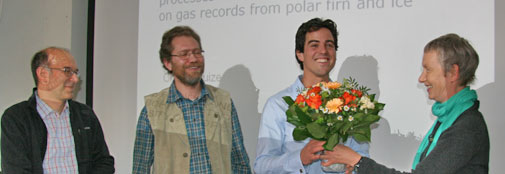Congratulations to Christo Buizert

Friday 23rd. of March 2012 Christo Buizert from Centre for Ice and Climate succesfully defended his PhD thesis.
Christo Buizert will continue his research at the University of Oregon.
The thesis is available here.
The influence of firn air transport processes and radiocarbon production on gas records from polar firn and ice
Abstract:
Air bubbles found in polar ice cores preserve a record of past atmospheric composition up to 800 kyr back in time. The composition of the bubbles is not identical to the ancient atmosphere, as it is influenced by processes prior to trapping, within the ice sheet itself, and during sampling and storage. Understanding of these processes is essential for a correct interpretation of ice core gas records. In my defense I focus on transport processes in the porous firn layer prior to bubble trapping.
I present a characterization of the firn air transport properties of the NEEM deep drilling site in Northern Greenland. The depth-diffusivity relationship needs to be reconstructed using reference tracers of known atmospheric history. I present a novel method of characterizing the firn transport using ten tracers simultaneously, thus constraining the effective diffusivity better than the commonly used single-tracer method would. A comparison between two replicate boreholes drilled 64m apart shows differences in measured mixing ratio profiles that exceed the experimental error, which we attribute to lateral inhomogeneities in firn stratigraphy. I present evidence that diffusivity does not vanish completely in the lock-in zone, as is commonly assumed. Six state-of-the-art firn air transport models are tuned to the NEEM site; all models successfully reproduce the data within a 1-sigma Gaussian distribution. I present the first intercomparison study of firn air models, where I introduce diagnostic scenarios designed to probe specific aspects of the model physics. The results show that there are major dierences in the way the models handle advective transport, and that diffusive fractionation of isotopes in the firn is poorly constrained by the models.
Using new laser-based methods the NEEM ice core has been analyzed for methane mixing ratios at an unprecedented spatial (and thereby temporal) resolution. I apply the firn air model tuned to the NEEM site to assess whether the experimental setup can capture all the methane variations recorded in the ice core, i.e. whether we are over- or undersampling the available climatic signal. It is found that the measurement technique can resolve all climatically relevant variations down to an ice depth of at least 1980m (66 kyr before present).
Finally, I describe an empirical method to calculate the magnitude of diffusive fractionation (DF) of isotopes in the ice core record. The method 1) requires little computational effort, 2) uses only commonly available ice core data, 3) does not require knowledge of the (unknown) true atmospheric history, and 4) is arguably more accurate than a full modeling study. I apply the DF correction to published methane isotope records over the last glacial termination and the 8.2 kyr event. In both cases the DF correction exceeds the analytical precision of the data during abrupt transitions. I argue that the corrected time series are more consistent than the uncorrected ones.
